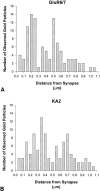Subcellular and subsynaptic localization of presynaptic and postsynaptic kainate receptor subunits in the monkey striatum
- PMID: 11698586
- PMCID: PMC6762275
- DOI: 10.1523/JNEUROSCI.21-22-08746.2001
Subcellular and subsynaptic localization of presynaptic and postsynaptic kainate receptor subunits in the monkey striatum
Abstract
The localization and functions of kainate receptors (KARs) in the CNS are still poorly known. In the striatum, GluR6/7 and KA2 immunoreactivity is expressed presynaptically in a subpopulation of glutamatergic terminals and postsynaptically in dendrites and spines. The goal of this study was to further characterize the subcellular and subsynaptic localization of kainate receptor subunits in the monkey striatum. Immunoperoxidase data reveal that the relative abundance of GluR6/7- and KA2-immunoreactive terminals is homogeneous throughout the striatum irrespective of the differential degree of striatal degeneration in Huntington's disease. Pre-embedding and post-embedding immunogold data indicate that >70% of the presynaptic or postsynaptic GluR6/7 and KA2 labeling is expressed intracellularly. In material stained with the post-embedding immunogold method, approximately one-third of plasma membrane-bound gold particles labeling in axon terminals and spines is associated with asymmetric synapses, thereby representing synaptic kainate receptor subunits. On the other hand, >60% of the plasma-membrane bound labeling is extrasynaptic. Both GluR6/7 and KA2 labeling in glutamatergic terminals often occurs in clusters of gold particles along the membrane of large vesicular organelles located at various distances from the presynaptic grid. Anterograde labeling from the primary motor cortex or the centromedian thalamic nucleus indicate that both corticostriatal and thalamostriatal terminals express presynaptic GluR6/7 and KA2 immunoreactivity in the postcommissural putamen. In conclusion, these data demonstrate that kainate receptors in the striatum display a pattern of subcellular distribution different from other ionotropic glutamate receptor subtypes, but consistent with their metabotropic-like functions recently shown in the hippocampus.
Figures









Similar articles
-
Presynaptic kainate receptors in the monkey striatum.Neuroscience. 1999;91(4):1195-200. doi: 10.1016/s0306-4522(99)00099-8. Neuroscience. 1999. PMID: 10391427
-
GABA(B) receptors at glutamatergic synapses in the rat striatum.Neuroscience. 2005;136(4):1083-95. doi: 10.1016/j.neuroscience.2005.07.013. Epub 2005 Oct 14. Neuroscience. 2005. PMID: 16226840
-
Group I metabotropic glutamate receptors in the monkey striatum: subsynaptic association with glutamatergic and dopaminergic afferents.J Neurosci. 2003 Aug 20;23(20):7659-69. doi: 10.1523/JNEUROSCI.23-20-07659.2003. J Neurosci. 2003. PMID: 12930805 Free PMC article.
-
GABA(B) and group I metabotropic glutamate receptors in the striatopallidal complex in primates.J Anat. 2000 May;196 ( Pt 4)(Pt 4):555-76. doi: 10.1046/j.1469-7580.2000.19640555.x. J Anat. 2000. PMID: 10923987 Free PMC article. Review.
-
Anatomy of adenosine A2A receptors in brain: morphological substrates for integration of striatal function.Neurology. 2003 Dec 9;61(11 Suppl 6):S12-8. doi: 10.1212/01.wnl.0000095205.33940.99. Neurology. 2003. PMID: 14663003 Review.
Cited by
-
Activation of presynaptic kainate receptors suppresses GABAergic synaptic transmission in the rat globus pallidus.Neuroscience. 2007 Oct 26;149(2):338-49. doi: 10.1016/j.neuroscience.2007.07.017. Epub 2007 Jul 20. Neuroscience. 2007. PMID: 17881134 Free PMC article.
-
Calcium-permeable AMPA and kainate receptors of GABAergic neurons.Biophys Rev. 2024 Apr 15;16(2):165-171. doi: 10.1007/s12551-024-01184-8. eCollection 2024 Apr. Biophys Rev. 2024. PMID: 38737208 Free PMC article. Review.
-
Localization and functions of kainate receptors in the basal ganglia.Adv Exp Med Biol. 2011;717:27-37. doi: 10.1007/978-1-4419-9557-5_3. Adv Exp Med Biol. 2011. PMID: 21713664 Free PMC article. Review.
-
The combination of chemical fixation procedures with high pressure freezing and freeze substitution preserves highly labile tissue ultrastructure for electron tomography applications.J Struct Biol. 2008 Mar;161(3):359-71. doi: 10.1016/j.jsb.2007.09.002. Epub 2007 Sep 14. J Struct Biol. 2008. PMID: 17962040 Free PMC article.
-
Glutamate and GABA receptors and transporters in the basal ganglia: what does their subsynaptic localization reveal about their function?Neuroscience. 2006 Dec 1;143(2):351-75. doi: 10.1016/j.neuroscience.2006.09.019. Epub 2006 Oct 23. Neuroscience. 2006. PMID: 17059868 Free PMC article. Review.
References
-
- Anwyl R. Metabotropic glutamate receptors: electrophysiological properties and role in plasticity. Brain Res Rev. 1999;29:83–120. - PubMed
-
- Aronin N, Chase K, Young C, Sapp E, Schwarz C, Matta N, Kornreich R, Landwehrmeyer B, Bird E, Beal MF, Vonsattel JP, Smith T, Carraway R, Boyce FM, Young AB, Penney JB, DiFiglia M. CAG expansion affects the expression of mutant huntingtin in the Huntington's disease brain. Neuron. 1995;15:1193–1201. - PubMed
-
- Baude A, Nusser Z, Roberts JD, Mulvihill E, McIlhinney RAJ, Somogyi P. The metabotropic glutamate receptor (mGluR1a) is concentrated at perisynaptic membrane of neuronal subpopulations as detected by immunogold reaction. Neuron. 1993;11:771–787. - PubMed
Publication types
MeSH terms
Substances
Grants and funding
LinkOut - more resources
Full Text Sources
Molecular Biology Databases
Miscellaneous
